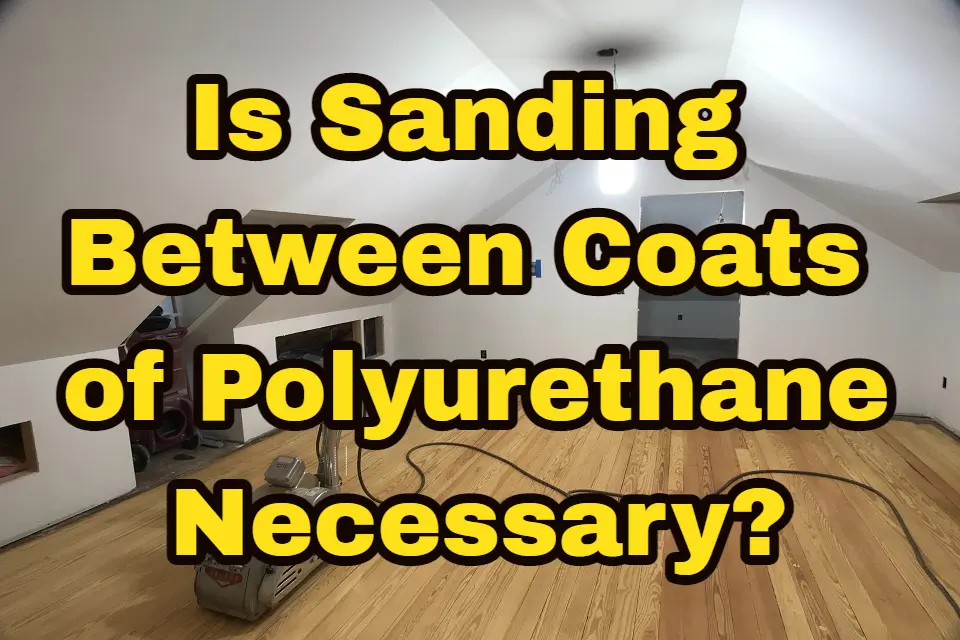Do you have to sand polyurethane between coats? Answering this question has been a tricky one among artists and painters. This is mainly due to the different methods and the preference of the crafter in question. Reading this article will clear the air if you’re unsure what to do when faced with this situation.
Here is what I discovered:
Do You Have to Sand Polyurethane Between Coats?
Sanding the Polyurethane between layers is necessary and must be done with fine sandpaper. This idea is to remove all dust, grime, or fine deposits of particles that settle on the surface in applying the poly product. Sanding will help you rub the surface while allowing for a smoother finish. In addition, sanding the urethane enhances the adhesion between coats.
But that’s just a quick answer to the question.
The article also addresses related and relevant questions about sanding poly coats and other surfaces.
Let’s keep on reading!
sanding between coats of Polyurethane is necessary
As earlier noted, sanding poly between coats is necessary for several reasons:
- sanding will eliminate all particles and dust that remain on the surface when the poly is wet.
- it reinforces inter-coat adhesion. This way, there will not be any loose points between each layer of your Polyurethane.
Sandpaper helps to rub the surface, thereby offering it a smooth finish. Once the sanding process takes off all blemishes and imperfections on the project’s surface, you won’t experience any sticky or tacky surface.
What happens if you don’t sand?
The consequences of not sanding between poly coats vary and can be dire, depending on the type of polyurethane product you’re using.
Not sanding your poly layers will not strengthen the bond between the coats.
The surface may also be left without serious dust and particles that will cause blemishes and tackiness issues. Eventually, it will deform and fall off.
What To Use?
- Orbital Sander
Yes, you can sander to polish the coat. However, it may leave you with a thin and scratched finish in Polyurethane. What you should do is to make sure that you apply the poly product in thin layers. Also, ensure the surface is fully dry before sanding it. Otherwise, since the orbital sander doesn’t spin relative to the workpiece, you might be left with an uneven surface if not correctly done.
- Sandpaper
The best fine-grit sandpaper to use on your Polyurethane is 320-grit sandpaper. But make sure you sand between coats lightly to avoid damaging the surface. You must leave the wet surface to dry thoroughly for a minimum of 24 hours before sanding.
- Steel Wool
A super-fine grade steel wool of “0000” (pronounced as ‘4 ought’) is best for sanding Polyurethane between coats. This steel wool leaves the surface with a nice, smooth, and even-looking sheen. To achieve a quality visual effect, you should first and foremost lubricate with soap and water and then rub out the finish.
The best way to sand between coats of Polyurethane on floors is by using steel wool or sandpaper because it helps create a uniform surface for another coat you apply.
How to sand Polyurethane between coats?
To achieve the best result, the total time to sand between coats is a minimum of two to four hours. It’s worth reiterating that you should allow the surface to dry before sanding.
Here are the supplies and tools you’ll need:
- Sanding sponges, blocks, and pads
- 320-grit sandpaper (to remove dust and scratches)
- Mineral spirits
- Polyurethane
- Sander
- Vacuum cleaner
- Brush or roller
- Cleaning agents
- Lint-free cloths
Steps on How to Sand Polyurethane between Coats
To start with, you should sand the entire project before you start, using 320- or 400-grit sandpaper. This way, you’ll have removed all small particles and defects before applying the poly coat.
- Prepare your work area and workpiece: Ensure the workspace is adequately ventilated to avoid inhaling harmful fumes released by Polyurethane. The temperature should be around 40-50 degrees Fahrenheit.
- Apply the first coat of Polyurethane.
- Allow the coat to dry fully. The drying time depends on your work area’s heat and humidity level. It may take up to 24 hours before it fully dries. Water-based poly takes typically about 4 hours to dry. Do not sand on wet polyurethane.
- Double the fine-grit sandpaper into folds to ensure it fits for easy handling
- Lightly run over the grit section of the sandpaper to the urethane wood finish. Make sure the sanding aligns in the same direction as the wood grain. The sanding should be done once to remove all lodged particles and dust.
- Using the tack cloth, clean the wood surface.
- Apply the second polyurethane coat. To protect your surface, you should apply a minimum of two coats of Polyurethane. If you are working on a surface that is prone to hard wear or moisture, apply a minimum of three coats. You may recoat after between 2 to 4 hours if you’re working with water-based Polyurethane to recoat. Oil-based Polyurethane may require a 10 to 24 hours wait before you can recoat Polyurethane after sanding.
- Let the coat dry completely.
- Sand the polyurethane finish surface the second time.
- Repeat. Repeat the process for the third time, depending on how many layers of Polyurethane you choose to put.
There’s no need to sand the final polyurethane coat. Since you’ve completed your project, you may not need to sand the final coat as this will not require recoating. You should hang out the project once the third or fourth layer is applied, dried, and sanded. But make sure adequate coating is done.
However, If you don’t want to sand between coats, applying Minwax Polyurethane using a brush foam to achieve your desired finish is best.
sanding hardwood floors between coats of Polyurethane
- Allow the first polyurethane coat to dry and cure for 24 hours while waiting for other coats for 1 to 2 days before sanding.
- Use a random orbital floor sander.
- Always use new sandpaper.
- Apply the first coat giving an excellent buffing using 180 or 220 grit sandpaper
- Do not apply too much pressure.
- Always begin at the end of the floor.
- Don’t send in large sections and just a direction.
- Clean up dust using shop vacuum after sanding.
- Fix uneven polyurethane finish by applying a light coat of Polyurethane to the sanded area using a brush and leave to dry. Repeat this process to achieve evenness
FAQs
Do you need to sand between coats of water-based Polyurethane?
Not necessarily. You don’t have to. Nothing will happen if you don’t sand between water-based polyurethane coats for some water-based polyurethane. However, most water-based may not adhere correctly.
Do you sand with mineral spirits between coats of Polyurethane?
This depends on what you need. You may sand with mineral spirits. The important thing is to wait for Polyurethane to cure fully. If it’s not fully cured, you may get the best result that you desire. This way, you may end up with a poor poly wood finish.
Does spray polyurethane require sanding between coats?
Yes, you sand between spray polyurethane coats. This is necessary to achieve a perfect finish. Sanding poly between coats reinforces the resistance and removes defects and dust. Here are the steps to sand poly between layers.
What should my floor look like after sanding Polyurethane between coats?
Your floor should look smooth and polished. Naturally, polyurethane varnish, when applied on wood, increases the surface’s resistance level to abrasion, chemicals, water, scratch, and heat.
Final words
Sanding the Polyurethane is necessary to make the surface smoother while enhancing the adhesion between coats. However, Sanding Polyurethane between coats may not be something everyone will do, not sanding Polyurethane between coats does not mean you will not achieve the best result as it only provides more smoothness to the surface while getting rid of dirt.

My name is Mark, and I am a software engineer and the founder of OnWoodWorkingArt.
I grew up with a passion for woodworking and now have my woodworking studio with a group of like-minded friends who love to create woodworking. My dream is to have a more extensive workshop and be able to make woodworking my main business.
